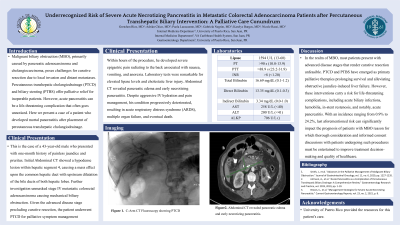Monday Poster Session
Category: Biliary/Pancreas
P1540 - Underrecognized Risk of Severe Acute Necrotizing Pancreatitis in Metastatic Colorectal Adenocarcinoma Patients After Percutaneous Transhepatic Biliary Intervention: A Palliative Care Conundrum
Monday, October 23, 2023
10:30 AM - 4:15 PM PT
Location: Exhibit Hall

Has Audio

Gretchen Rios, MD
University of Puerto Rico
San Juan, Dominican Republic
Presenting Author(s)
Gretchen Rios, MD1, Adrian Chico, MD2, Nicole Rassi-Stella, MD1, Gabriela Negron, MD1, Paola Laracuente-Román, MD3, Karelys Burgos-Irizarry, MD4
1University of Puerto Rico, San Juan, Puerto Rico; 2VA Caribbean Healthcare System, San Juan, Puerto Rico; 3University of Puerto Rico, Medical Sciences Campus, San Juan, Puerto Rico; 4University of Puerto Rico Medical Sciences Campus, San Juan, Puerto Rico
Introduction: Malignant biliary obstruction (MBO), primarily caused by pancreatic adenocarcinoma and cholangiocarcinoma, poses challenges for curative resection due to local invasion and distant metastases. Percutaneous transhepatic cholangiodrainage (PTCD) and biliary stenting (PTBS) offer palliative relief for inoperable patients. However, acute pancreatitis can be a life-threatening complication that often goes unnoticed. Here we present a case of a patient who developed mortal pancreatitis after placement of percutaneous transhepatic cholangiodrainage.
Case Description/Methods: This is the case of a 43-year-old male who presented with one-month history of painless jaundice and pruritus. Initial Abdominal CT showed a hypodense lesion within hepatic segment 4, causing a mass effect upon the common hepatic duct with upstream dilatation of the bile ducts of both hepatic lobes. Further investigation unmasked stage IV metastatic colorectal adenocarcinoma causing mechanical biliary obstruction. Given the advanced disease stage precluding curative resection, the patient underwent PTCD for palliative symptom management. Within hours of the procedure, he developed severe epigastric pain radiating to the back associated with nausea, vomiting, and anorexia. Laboratory tests were remarkable for elevated lipase levels and cholestatic liver injury. Abdominal CT revealed pancreatic edema and early necrotizing pancreatitis. Despite aggressive IV hydration and pain management, his condition progressively deteriorated, resulting in acute respiratory distress syndrome (ARDS), multiple organ failure, and eventual death.
Discussion: In the realm of MBO, most patients present with advanced disease stages that render curative resection unfeasible. PTCD and PTBS have emerged as primary palliative therapies prolonging survival and alleviating obstructive jaundice-induced liver failure. However, these interventions carry a risk for life-threatening complications, including acute biliary infections, hemobilia, in-stent restenosis, and notably, acute pancreatitis. With an incidence ranging from 0.9% to 24.2%, last aforementioned risk can significantly impact the prognosis of patients with MBO reason for which thorough consideration and informed consent discussions with patients undergoing such procedures must be entertained to improve treatment decision-making and quality of healthcare.
Disclosures:
Gretchen Rios, MD1, Adrian Chico, MD2, Nicole Rassi-Stella, MD1, Gabriela Negron, MD1, Paola Laracuente-Román, MD3, Karelys Burgos-Irizarry, MD4. P1540 - Underrecognized Risk of Severe Acute Necrotizing Pancreatitis in Metastatic Colorectal Adenocarcinoma Patients After Percutaneous Transhepatic Biliary Intervention: A Palliative Care Conundrum, ACG 2023 Annual Scientific Meeting Abstracts. Vancouver, BC, Canada: American College of Gastroenterology.
1University of Puerto Rico, San Juan, Puerto Rico; 2VA Caribbean Healthcare System, San Juan, Puerto Rico; 3University of Puerto Rico, Medical Sciences Campus, San Juan, Puerto Rico; 4University of Puerto Rico Medical Sciences Campus, San Juan, Puerto Rico
Introduction: Malignant biliary obstruction (MBO), primarily caused by pancreatic adenocarcinoma and cholangiocarcinoma, poses challenges for curative resection due to local invasion and distant metastases. Percutaneous transhepatic cholangiodrainage (PTCD) and biliary stenting (PTBS) offer palliative relief for inoperable patients. However, acute pancreatitis can be a life-threatening complication that often goes unnoticed. Here we present a case of a patient who developed mortal pancreatitis after placement of percutaneous transhepatic cholangiodrainage.
Case Description/Methods: This is the case of a 43-year-old male who presented with one-month history of painless jaundice and pruritus. Initial Abdominal CT showed a hypodense lesion within hepatic segment 4, causing a mass effect upon the common hepatic duct with upstream dilatation of the bile ducts of both hepatic lobes. Further investigation unmasked stage IV metastatic colorectal adenocarcinoma causing mechanical biliary obstruction. Given the advanced disease stage precluding curative resection, the patient underwent PTCD for palliative symptom management. Within hours of the procedure, he developed severe epigastric pain radiating to the back associated with nausea, vomiting, and anorexia. Laboratory tests were remarkable for elevated lipase levels and cholestatic liver injury. Abdominal CT revealed pancreatic edema and early necrotizing pancreatitis. Despite aggressive IV hydration and pain management, his condition progressively deteriorated, resulting in acute respiratory distress syndrome (ARDS), multiple organ failure, and eventual death.
Discussion: In the realm of MBO, most patients present with advanced disease stages that render curative resection unfeasible. PTCD and PTBS have emerged as primary palliative therapies prolonging survival and alleviating obstructive jaundice-induced liver failure. However, these interventions carry a risk for life-threatening complications, including acute biliary infections, hemobilia, in-stent restenosis, and notably, acute pancreatitis. With an incidence ranging from 0.9% to 24.2%, last aforementioned risk can significantly impact the prognosis of patients with MBO reason for which thorough consideration and informed consent discussions with patients undergoing such procedures must be entertained to improve treatment decision-making and quality of healthcare.
Disclosures:
Gretchen Rios indicated no relevant financial relationships.
Adrian Chico indicated no relevant financial relationships.
Nicole Rassi-Stella indicated no relevant financial relationships.
Gabriela Negron indicated no relevant financial relationships.
Paola Laracuente-Román indicated no relevant financial relationships.
Karelys Burgos-Irizarry indicated no relevant financial relationships.
Gretchen Rios, MD1, Adrian Chico, MD2, Nicole Rassi-Stella, MD1, Gabriela Negron, MD1, Paola Laracuente-Román, MD3, Karelys Burgos-Irizarry, MD4. P1540 - Underrecognized Risk of Severe Acute Necrotizing Pancreatitis in Metastatic Colorectal Adenocarcinoma Patients After Percutaneous Transhepatic Biliary Intervention: A Palliative Care Conundrum, ACG 2023 Annual Scientific Meeting Abstracts. Vancouver, BC, Canada: American College of Gastroenterology.
